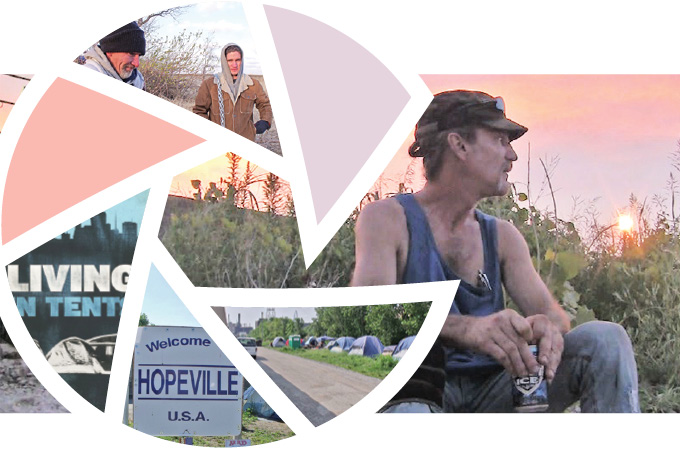Seven years ago, if you traveled north of Lumière Place and the America’s Center Convention Complex, you would find something unexpected along the banks of the Mississippi: a tent city. The homeless community was dismantled by the city in 2012, but St. Louisans still can get an intimate look inside the encampment thanks to local filmmaker Paul Crane’s documentary, Living in Tents. The film offers an insightful perspective on homelessness in St. Louis and its residents who survive without permanent shelters or resources.
Crane, who grew up in Olivette, says homelessness wasn’t on his radar before his experience with the tent city. “I didn’t know anything about it before this project,” he explains. “That is what really interested me in telling the story. I was curious to learn about the homeless, why people would choose a tent city over a shelter and why they are allowed to.”
Crane encountered the encampment by accident. While looking for inspiration for a photography class he was taking, he came across a collection of tarps, tents and shacks on the riverfront. “I was out taking pictures and just stumbled upon it,” he recalls. “I was hesitant to approach, but I did eventually.” The tent city was divided into three smaller camps, each with its own name and leader: Sparta, Hopeville and Dignity Harbor. The first person Crane met was Wulf, the man in charge of Sparta. He showed Crane around and explained some of the camp’s rules.
While he had little documentary filmmaking experience at the time, after regular visits, Crane was inspired to chronicle day-to-day life in the community. He was a fan of Marc Singer’s documentary Dark Days, which followed a group of people living in an abandoned section of New York’s subway system and felt he could do something similar. “There were so many stories in the camps,” he says. “The people living there, the volunteers who worked there—it was a lot of material to work with. Making a film seemed like the obvious thing to do, and I was super excited about the project.”
Living in Tents follows five residents of the tent city and five volunteers who worked with the homeless living there. As part of the process, Crane temporarily moved into Sparta in January of 2011. He had a tent set up for three months and would spend two nights a week there. “It wasn’t an experiment in trying to be homeless,” he says. “I wanted to earn people’s trust and capture as much that happened as I could.” He admits now that he was probably a little naïve initially, but the camaraderie he built with Wulf and others made him feel safe.
While filming, Crane not only captured the daily existence of the residents and their stories, but also the city’s response to the tent city, including interviews with Bill Siedhoff, director of the department of human services for the city of St. Louis at the time. While the encampment was founded with good intentions, the film documents its eventual decline. Fires, infighting and even a homicide all played a role in the city’s decision to shut down the three camps.
The residents weren’t simply left out on the street. Through private funding, the city placed them in apartments with the hope that after a year, they would find employment and take over payment of rent and utilities. Crane was on hand to document the transition from tents to apartments and also followed up once the one-year deadline had expired. “Originally, I didn’t expect filming to last several years, but I thought their continued journeys were important to capture,” he says. “When I put the film together, it was really cool to see all that happened and what people had gone through.”
Eight years after stumbling across the tent city, Crane is still in contact with many of its former residents. He says the experience taught him about the struggles the homeless deal with every day, including addiction, mental illness and past trauma. “I’d like to think I was already compassionate, but making Living In Tents gave me a deeper understanding of why homelessness happens and will continue to happen,” he notes. “I want the film to be an opportunity for people to get know these individuals and learn about them and their problems.”
>> Living in Tents is now streaming on Amazon and will be screened as part of the St. Louis International Film Festival at .ZACK NOV. 4.
Pictured above: Blake, a resident of the tent city








